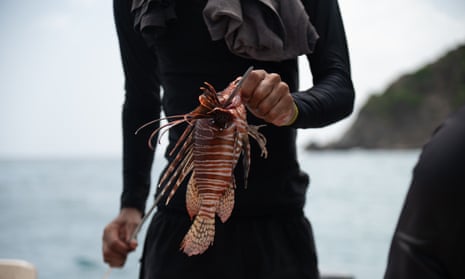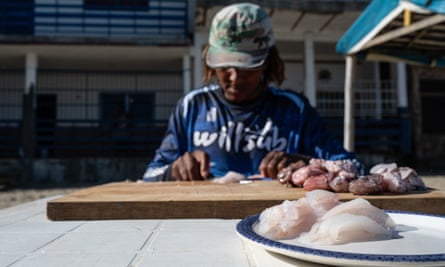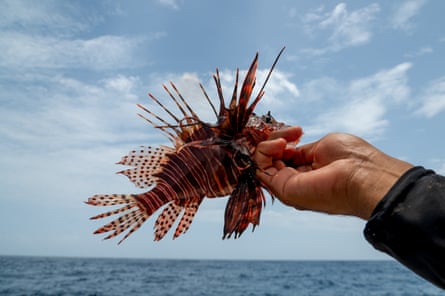Beautiful, dramatically coloured and barbed with venomous spikes, the lionfish not only looks dangerous but is proving to be a grave threat to every other fish in the Caribbean. In Venezuela, William Álvarez, who lives in Chichiriviche de la Costa bay on the Caribbean country’s central coast, has made it his business to see off the threat. Each day, he removes them from the water one by one. He is also encouraging tourists and others in the fishing community to catch and eat the lionfish in an effort to control its voracious expansion. The species is decimating herbivorous fish that are important to coral reefs and the livelihoods of coastal communities.

William Álvarez (right), fisher Rafael Mayora and diver Ricardo Ferrebus discover the shell of an endangered green turtle (Chelonia mydas)
“The sea is my livelihood and I know what is happening: the lionfish is wiping out other species and there is no one to control it, so every time I go into the sea with my harpoon it is an opportunity to remove them,” says Álvarez, 37, after a day of fishing.
Lionfish were unintentionally introduced to the region from the Indian and Pacific oceans, where they coexist with natural predators such as large moray eels, sharks, groupers and toadfish.


From left: Rafael Mayora, William Álvaez and Ricardo Ferrabus after a day’s fishing; Álvarez cleans a mackerel on the beach
But in the Caribbean Sea there are no natural predators. The bright orange, brown and black lines that cover the lionfish’s body, along with its poison-laden spikes, serve as a warning to other species that consider feeding on it. Some fish flee upon seeing it.

William Álvarez: ‘You can’t just cast a net, you have to spear them one by one’
“It is not easy to catch. If it gets caught in a net, you run the risk of getting hurt by one of its barbs and then you’ll be unable to work for several days,” says Rafael Mayora, 26, who often works with Álvarez. “That’s why many fishers simply decide not to go near it. Its presence is also a risk for tourists.”
Because fishers tend to avoid the species, and because it breeds so rapidly – laying up to 30,000 eggs every four days – there has been a noticeable rise in numbers. The best technique to catch them, says Álvarez, is to use a spear or harpoon, but that is a time-consuming process.
“You can’t just cast a net and pull them all out, you have to spear them one by one, only some divers and spear fishermen do that,” he says.
“I’m worried. I know it’s an emergency situation, because when I go to some caves that I haven’t checked before, sometimes I find more lionfish than other species because they eat the small fish before their reproductive age, which is critical.”




Preparing lionfish to eat: first it is important to remove the dorsal fin, where the venomous spines are located, then the fish can be turned into ceviche, which has become a common dish in Chichiriviche de la Costa
Álvarez is promoting the catching and consumption of this species through his social networks and pushing the idea among tourists and local people.
“I take lionfish out all the time. Sometimes I cook them to sell, sometimes to share with the family, but there are always fresh lionfish in my freezer,” he says.
“Humans are predators par excellence and I think that, in this case, we are the only ones who can help control the situation in the Caribbean, because there have been tests trying to get other species to feed on them, but nothing has worked,” he adds.
Álvarez dives 20 to 30 metres to fish, and each time removes lionfish, along with any plastic he finds on the seabed.
“I know what I am doing doesn’t have the impact I’d like, I’m not going to change the situation or put an end to pollution or lionfish or illegal fishing of protected species, but I believe that if everyone does their bit, things will improve,” he says.
Lionfish: the facts

The lionfish has spread across reef ecosystems in the Atlantic, Gulf of Mexico and Caribbean, where it feeds on eggs, small fish, crustaceans and molluscs
Lionfish, which are native to the Indian and Pacific oceans, have become one of the most damaging marine invasive species on the planet. Invasive species are defined by having few or no predators once they enter a new ecosystem, causing their population to explode and crowd out others, stopping the ecosystem from healthily functioning in the process.
The lionfish – a voracious predator – has spread across reef ecosystems in the Atlantic, Gulf of Mexico and Caribbean at astonishing speed, releasing thousands of eggs every few days, and up to 2m a year. They feed on smaller fish that are important for commercial species, such as snapper and grouper, and fish that are key for maintaining the health of coral reefs. A controlled experiment in 2008 found that populations of juvenile reef fish could crash 80% within five weeks once lionfish appeared in the Bahamas.
Conservationists are encouraging people to eat the invasive fish, which has now spread to the Mediterranean, to keep their numbers in check, with regular fishing tournaments now held in Florida and the Caribbean.
In September, a UN assessment found that invasive species were costing the world $423bn (£340bn) a year and had become a leading threat to diversity on Earth, with marine ecosystems at threat from non-native species.
